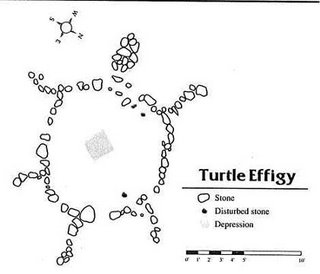I just made up a new word, simularocka.
Thanks Norman.
So speaking of turtles, here’s what I found about one accepted turtle effigy…
From the html version of the file http://www.mt.blm.gov/ndfo/coteau/coteaufeis/appendixd.pdf:
“Stone effigies are arrangements of stones intended to portray specific figures or symbols. Zoomorphic effigies (Davis 1975:32; Hoffman 1953:12) and anthropormorphic representations (Deaver and Deaver 1984:16-21) have been reported at a number of locations….Site 32ME1486, commonly called “the turtle effigy” was determined eligible for listing on the National Register of Historic Places as a Traditional Cultural Property. The site contains an effigy figure that has documented uses for traditional cultural purposes for a minimum of three generations and is actively used today (Deaver 2001).
The Crow and the Three Affiliated Tribes (
My Google search of images got me this one tiny photo:
52. Turtle Effigy State Historic Site -- Located near Golden Valley, Mercer County, this site preserves a twenty-one-foot-long turtle petroform--an animal shape formed of stones. Made by Native Americans prior to European immigration, this type of site is rare and not accessible to the public.
State Historic Sites Administered by the State Historical Society of
http://www.state.nd.us/hist/sites/aborig.htm
And then I found this: Photo by Calvin Grinnell
Photo by Calvin Grinnell
Within traditional Hidatsa territory, on lands later shared with the
"This is the only effigy I ever saw but heard that the old people knew of many others down the river near their old villages and would go there to make offerings. Anyone could make offerings of knives, pieces of hides, or dry meat and other things to eat when asking for rain or other good luck such as living to be old. If they had children, they would ask the gods that go with the turtle to send good luck. To give to the turtle was the same as giving to all the other gods that went with the bundle.
"While we stopped near the turtle, people made offerings to the turtle and the other gods that went with it. Some left knives but in the olden times the flint knife was given, for the flint was the sign of the big birds who go with the turtle and the other gods in the
"After we moved on from this turtle it was so foggy one day that the leader could hardly find his way. The hunters had to hold each other's hands to keep from getting lost. An Arikara brought a knife and gave it to Clam Necklace (
Turtle and other effigies are rare and fragile resources. Vehicle traffic, unauthorized digging, souvenir collection, and cultivation have destroyed many of these sites.
Photos by Calvin Grinnell
http://www.trailtribes.org/kniferiver/all-my-relations.htm#turtle
Turtle Effigy Diagram
Courtesy of
From the Link to diagram of a turtle effigy



4 comments :
Reminds me of that petroform of a man up in Canada . . . now I'm going to have to search for that.
"Vehicle traffic, unauthorized digging, souvenir collection" these are some of the things that worry me about making information about sites more available.
I almost included the Bannock Point turtle in Manitoba...
Well if you guys care to look at the list of links at the top right of the blog - you will see a link to Bannock Point. Nonetheless I am glad Tim brought over some of that information.
Time to mention again a philosophy that was stated in the early days of this blog: that publishing sites has rewards as well as risks. Ongoing secrecy is not an option if we want this subject to be known to the public. The alternative is limited publicization following some guidelines I wrote about. In fact if you search on the word "guidelines" this takes you to them.
Post a Comment